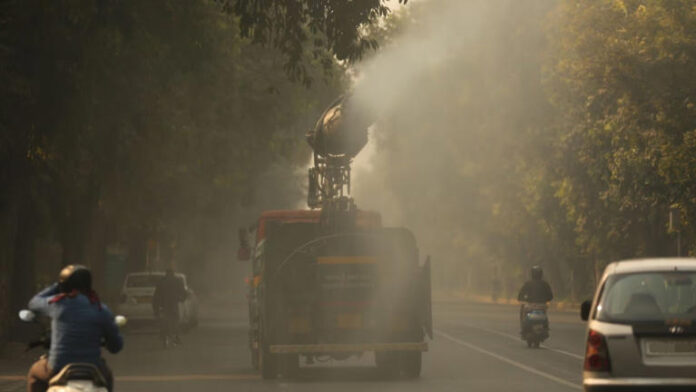Last week, a town located on the Assam-Meghalaya border found itself in the global spotlight for all the wrong reasons, earning the unfortunate distinction of being the “world’s worst polluted” according to environmental research data. This alarming label has drawn widespread attention, prompting both Assam and Meghalaya to address the issue head-on. Local authorities from both states have expressed a joint commitment to tackle the escalating pollution levels and restore the town to a cleaner, healthier state for its residents.
The Disturbing Findings
The town in question, which straddles the border between Assam and Meghalaya, has long struggled with industrial pollution, poor waste management, and environmental degradation. However, recent reports and air quality assessments brought it into the global focus, with data showing alarmingly high levels of particulate matter (PM2.5) in the atmosphere. These findings were made public when environmental research bodies, including the World Air Quality Index (WAQI), ranked the town as the most polluted place on Earth.
The pollution levels in the town were so severe that they surpassed those of notorious pollution hotspots like Delhi and Beijing. These high levels of particulate matter, particularly PM2.5, can lead to a range of health problems such as respiratory issues, heart disease, and other life-threatening conditions, making it a matter of immediate concern for the health and well-being of the town’s residents.
The Cause of Pollution
The town’s pollution woes can largely be attributed to several factors, with industrial activities, unregulated mining, and vehicular emissions taking the forefront. The region, rich in natural resources like coal, has seen a rise in mining operations over the years. However, many of these operations are not compliant with environmental regulations, leading to the destruction of forests, improper disposal of waste, and the release of harmful pollutants into the air and water systems.
In addition to industrial activities, the rapid growth of the town’s population has led to increased waste production. The lack of a proper waste management system has resulted in the accumulation of garbage in public spaces, further exacerbating the pollution crisis. The town’s proximity to the busy National Highway 6 also contributes to high vehicular emissions, adding to the environmental burden.
Joint Efforts by Assam and Meghalaya
In response to the troubling reports, the state governments of Assam and Meghalaya have expressed their joint commitment to reversing the situation. Both states are now collaborating on multiple fronts to restore environmental balance in the region and address the root causes of the pollution crisis.
Assam’s Chief Minister Himanta Biswa Sarma and Meghalaya’s Chief Minister Conrad Sangma have both vowed to implement immediate measures aimed at improving air quality, reducing industrial pollution, and enhancing waste management systems in the affected town. Both states are working together on a comprehensive plan that will involve local stakeholders, environmental experts, and community members to ensure effective implementation.
One of the key strategies discussed is the introduction of stricter regulations on industrial emissions and mining activities. Both state governments have promised to crack down on illegal mining operations and enforce stringent pollution control measures. Additionally, they plan to introduce new technologies for dust suppression and cleaner production processes in industrial units.
Improving Waste Management and Public Awareness
Another critical aspect of the plan is improving the town’s waste management system. Both states have agreed to collaborate on setting up proper waste segregation, collection, and disposal mechanisms. This will not only address the issue of garbage accumulation but also reduce the risk of land and water pollution, which contributes to the overall environmental degradation.
Local authorities are also working to educate the public about the importance of waste reduction, recycling, and proper disposal practices. Awareness campaigns will be launched to inform residents about the health risks associated with pollution and the steps they can take to reduce their environmental impact.
Focus on Long-Term Solutions
While the immediate measures to curb pollution are vital, both states recognize that a long-term solution is needed to ensure that the town does not revert to its polluted state in the future. As such, the governments of Assam and Meghalaya are planning to invest in sustainable infrastructure and green technologies.
Efforts to promote the use of clean energy sources such as solar power are also in the pipeline. The introduction of electric vehicles (EVs) and incentives for adopting eco-friendly alternatives will be part of the long-term vision to reduce the town’s carbon footprint. Furthermore, the states are keen on promoting reforestation programs in areas affected by illegal mining to help restore the natural balance of the region.
The Role of the Community
In addition to government efforts, local communities play a crucial role in the success of these initiatives. Both states are encouraging residents to participate in the cleanup process by organizing community-driven clean-up drives, tree plantation programs, and workshops focused on sustainable living. Public participation in these efforts will be critical in creating lasting change and ensuring that the town’s environment is protected for future generations.
The “world’s worst polluted” tag that the town on the Assam-Meghalaya border recently received has become a wake-up call for both states. The combined efforts of Assam and Meghalaya to tackle pollution in the region are a hopeful step forward, with both governments making firm commitments to improve air quality, regulate industrial activity, and promote environmental sustainability. While the road to recovery may be long, the joint action plan laid out by the states, along with community participation, offers a promising path to cleaner air and a healthier environment for the residents of the town. Through cooperation and responsible environmental practices, the goal of transforming the region into a model of ecological balance and sustainable living is now within reach.




